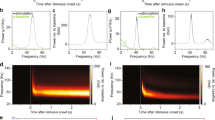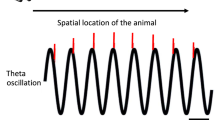Abstract
The stochastic structure of the spike activity generated by a movement processing wide-field element in the visual system of the fly has been studied over the whole performance area of the neuron. The structure of this discharge is described in terms of an Adaptive Integrate-to-Threshold model for a wide variety of spatio-temporal stimuli as well as steady-state stimuli. In order to reproduce the experimental results it is shown that the source of randomness in the model (e.g. the threshold) behaves like a random variable which is distributed according to a two-state Markov renewal process. In the case of stationary discharges generated by moving sinewave patterns the shape of the interspike interval distribution (which, in the Integrate-to-Threshold model, reflects the shape of the threshold distribution) changes continuously from a two-state distribution at low firing rates to a one-state distribution at high firing rates. In dynamic conditions of the discharge, generated by temporal dynamic stimuli, the experimental results show that the shape of the (demodulated) interval distribution of the discharge is determined by the highest instantaneous firing rate with an adaptation time constant of a few seconds. The physioligical origin of this intriguing behaviour remains — up till now — out of the picture.
Similar content being viewed by others
References
Bruckstein, A.M., Zeevi, Y.Y.: Analysis of “Integrate-to-threshold” neural coding schemes. Biol. Cybernetics 34, 63–79 (1979)
Fitzhugh, R.: A statistical analyzer for optic nerve messages. J. Gen. Physiol. 41, 675–692 (1958)
Gestri, G., Maffei, L., Petracchi, D.: Spatial and temporal organization in retinal units. Kybernetik 3, 196–202 (1966)
Gestri, G., Petracchi, D.: The transformation induced by light stimulus on the retinal discharge: study of the interval distribution at high frequencies of sinusoidal stimulation. Kybernetik 6, 171–176 (1970)
Gestri, G.: Pulse frequency modulation in neural systems. A random model. Biophys. J. 11, 98–109 (1971)
Gestri, G., Piram, P.: On the autocorrelation of one class of nonstationary random point processes. Biol. Cybernetics 17, 199–205 (1975)
Gestri, G.: Dynamics of a model for the variability of the interspike intervals in a retinal neuron. Biol. Cybernetics 31, 97–98 (1978)
Hermann, H.T., Olsen, R.E.: Dynamic statistics of crayfish caudal photoreceptors. Biophys. J. 7, 279–296 (1967)
Knox, C.K.: Signal transmission in random spike trains with applications to the statocyst neurons of the lobster. Kybernetik 7, 167–174 (1970)
Levine, M.W., Shefner, J.M.: A model for the variability of interspike intervals during sustained firing of a retinal neuron. Biophys. J. 19, 241–252 (1977)
Li, C.C.: Integral pulse frequency modulated control systems. Thesis, Northwestern Univ. Evanston 1961
McCann, G.D., Foster, S.F.: Binocular interactions of motion detection fibers in the optic lobes of flies. Kybernetik 8, 193–204 (1971)
Mastebroek, H.A.K.: Stochastic structure of neural activity in the visual system of the blowfly. Thesis, Groningen Univ. 1974
Mastebroek, H.A.K., Zaagman, W.H., Kuiper, J.W.: Intensity and structure of visually evoked neural activity: rivals in modelling a visual system. Vision Res. 17, 29–35 (1977)
Mastebroek, H.A.K., Zaagman, W.H., Lenting, B.P.M.: Movement detection: performance of a wide-field element in the visual system of the blowfly. Vision Res. (in press) (1980)
Siebert, W.M.: Some implications of the stochastic behaviour of primary auditory neurons. Kybernetik 2, 206–215 (1965)
Smith, C.E.: A comment on a retinal neural model. Biophys. J. 25, 385–386 (1979)
Zaagman, W.H., Mastebroek, H.A.K., Buyse, T., Kuiper, J.W.: Receptive field characteristics of a directionally selective movement detector in the visual system of the blowfly. J. Comp. Physiol. 116, 39–50 (1977)
Zaagman, W.H., Mastebroek, H.A.K., Kuiper, J.W.: On the correlation model: performance of a movement detecting neural element in the fly visual system. Biol. Cybernetics 31, 163–168 (1978)
Author information
Authors and Affiliations
Rights and permissions
About this article
Cite this article
Gestri, G., Mastebroek, H.A.K. & Zaagman, W.H. Stochastic constancy, variability and adaptation of spike generation: Performance of a giant neuron in the visual system of the fly. Biol. Cybernetics 38, 31–40 (1980). https://doi.org/10.1007/BF00337399
Received:
Issue Date:
DOI: https://doi.org/10.1007/BF00337399




